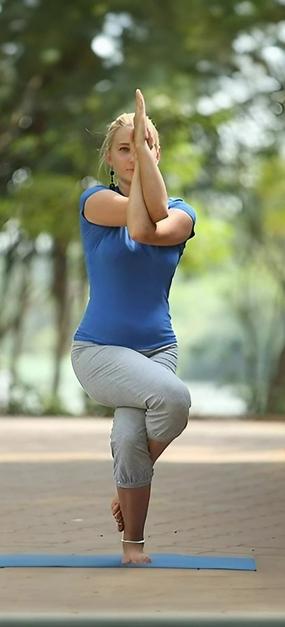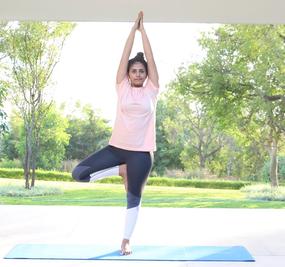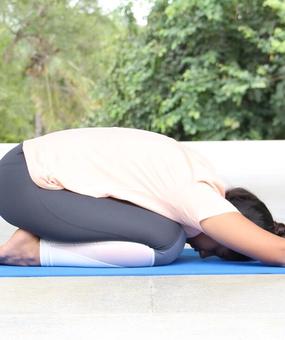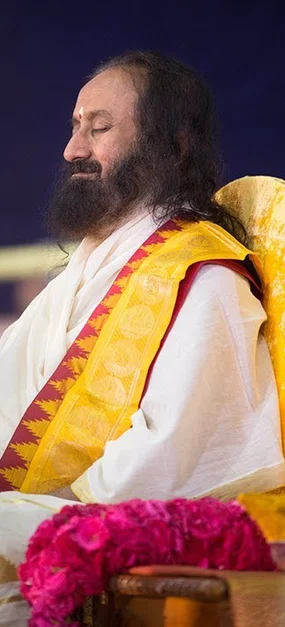This pose strengthens the arms, shoulders, thighs and back muscles, all in one go. This pose is named after Veerabhadra, a fierce warrior, an incarnation of Lord Shiva. The story of the warrior Veerabhadra, as all stories from Upanishads, has a moral that adds value to our life.
Veera – vigorous, warrior, courageous; Bhadra – good, auspicious; Asana – Posture
Virabhadrasana or Veerabhadrasana The asana is pronounced as Vee- Ra- Bha- Dra-aasana.
How to do Virabhadrasana
Veerabhadrasana or Virabhadrasana is one of the most graceful yoga postures and it adds beauty and grace to one’s yoga practice.
- Stand straight with your legs wide apart by a distance of at least 3-4 feet.
- Turn your right foot out by 90 degrees and left foot in by about 15 degrees.
- Checkpoint: Is the heel of the right foot aligned to the center of the left foot?
- Lift both arms sideways to shoulder height with your palms facing upwards.
- Checkpoint: Are your arms parallel to the ground?
- Breathing out, bend your right knee.
- Checkpoint: Are your right knee and right ankle forming a straight line? Ensure that your knee does not overshoot the ankle.
- Turn your head and look to your right.
- As you settle down in the yoga posture stretch your arms further.
- Make a gentle effort to push your pelvis down. Hold the yoga posture with the determination of a warrior. Smile like a happy smiling warrior. Keep breathing as you go down.
- Breathing in, come up.
- Breathing out, bring your hands down from the sides.
- Repeat the yoga posture for the left side (turn your left foot out by 90 degrees and turn the right foot in by about 15 degrees).
Benefits
- Strengthens and tones the arms, legs and lower back.
- Improves balance in the body, helps increase stamina.
- Beneficial for those with sedentary or deskbound jobs.
- Extremely beneficial in case of frozen shoulders.
- Releases stress in the shoulders very effectively in a short span of time.
- Brings auspiciousness, courage, grace and peace.
Contraindications
- Practice Warrior Pose (Veerabhadrasana) only after consulting your doctor if you have experienced spinal disorders recently or just recovered from a chronic illness.
- High blood pressure patients should avoid this posture.
- Veerabhadrasana especially benefits pregnant ladies in their second and third trimester provided they have been practicing yoga regularly. Practice Virabhadrasana while standing close to a wall so you can support yourself if required. However do consult your doctor before doing this yoga posture.
- Avoid this posture if you are suffering or had recently suffered from diarrhea.
- If you have knee pain or arthritis, use some support at the knee to hold this yoga posture.
FAQ’s on Veerabhadrasana (Warrior Pose)
Benefits of Virabhadrasana: It strengthens and tones the arms, legs and lower back. It improves the balance of the body and helps increase stamina. It is beneficial for those with sedentary or deskbound jobs. It is beneficial in the case of frozen shoulders. It releases stress in the shoulders very effectively in a short period.
Benefits of Vrikshasana: It rejuvenates the whole body. It stretches the legs, back and arms. It brings balance and equilibrium to your mind. It helps improve concentration. It relieves sciatica pain. It makes the legs strong, improves balance, and opens the hips.
Benefits of Chakrasana: It increases energy and heat It strengthens the arms, legs, spine, thigh and abdomen It opens the chest It stretches the shoulders, hip flexors and core It increases flexibility in the spine
The arms, legs, shoulders and lower back are benefited by Veerbhadrasana.
Follow the steps shown in the video of Virabhadrasana. Practice the asana with the determination of a warrior. Check if your right knee and ankle form a straight line. Take care that your knee does not overshoot the ankle.
Warrior pose is good for: It strengthens and tones the arms, legs and lower back. It improves the balance of the body and helps increase stamina. It is beneficial for those with sedentary or deskbound jobs. It is beneficial in the case of frozen shoulders. It releases stress in the shoulders very effectively in a short period.
The five Warrior poses are: Warrior I / Virabhadrasana I. Warrior II / Virabhadrasana II. Warrior III / Virabhadrasana III. Reverse Warrior / Viparita Virabhadrasana. Humble Warrior / Baddha Virabhadrasana. Retreating Warrior.
Holding open body postures for two minutes every day boosts your confidence. Get the confidence of a warrior by holding the Virabhadrasana for only two minutes daily.
It is difficult to get in Warrior pose if you are committing these mistakes: Too short a stance – If your front thigh is not parallel to the floor, you can lengthen your stance. Misalignment in Warrior II is that the knee of the back leg is sprained and locked while the hip collapses forward. Not engaging both your legs – We tend to do justice with the front leg but forget to track down your back leg. Root from your pelvis down into your back heel. Press strongly through your back heel as you bend your front knee toward 90 degrees. Square the hips – Avoid squaring your hips as our skeletal structure may not rotate to the thigh a full 90 degrees.















